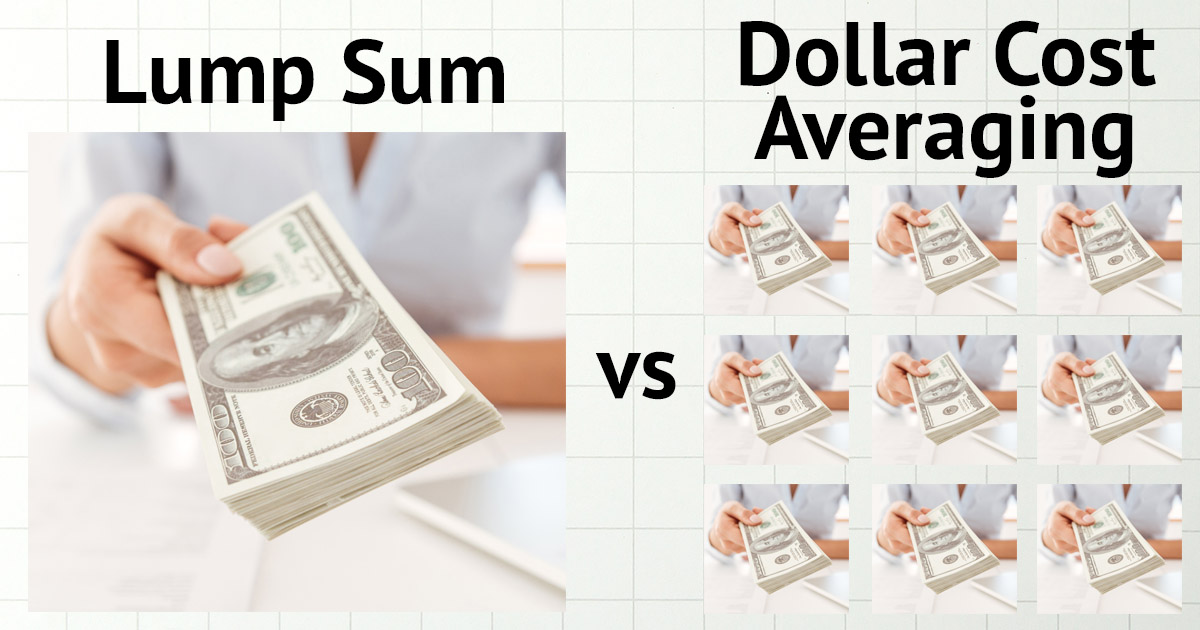Is Lump Sum Versus Dollar Cost Averaging Better?
- June 28, 2019
- by Michael

Let’s say you have $12,000 cash to invest in the markets. What is the best way to deploy that money - all at once or spread out over time? It depends on your risk tolerance. Our calculators shed some additional light on the subject.
Lump sum investing - the entire amount is invested in one go.
- Pro’s: least amount of work, generally leads to higher returns.
- Con’s: risk of a negative shock in the next few months, which would make you feel bad about doing it that way. Limits flexibility if you change your mind later.
Dollar cost averaging - the full amount is broken up into a series of payments that are invested over a period of time.
- Pro’s: avoids risk of a sudden negative downturn, retains some cash in case your plans change
- Con’s: more work to setup and track, can lead to lower returns in the long run.
Let’s explore two different scenarios and see how the numbers come out when investing $12,000. Both scenarios will run for 10 years. The lump sum scenarios puts all $12,000 in up front. The dollar cost average scenario contributes $4,000 a year for three years. The average resulting balances are taken from our Saving for Retirement Calculator.
Scenario A - 80% stocks, 20% bonds after 10 years:
| Lump Sum | Dollar Cost Average |
|---|---|
|
$30,900 |
$25,600 |
With dollar cost averaging the calculator shows you end up with about $5,500 less vs lump sum!
Dollar cost averaging is lower in this case because keeping the money on the sidelines, on average, reduced the positive effects of compounding. In this example being risk averse ended up being expensive in the long run. One small caveat about the calculators - while sidelined the cash was assumed to earn zero interest. This has a minor impact. If you increase the contribution by 2% per year the average return increases by about $82.
Now let’s try a more conservative allocation, 20% stocks, 80% bonds.
Scenario B - 20% stocks, 80% bonds after 10 years:
| Lump Sum | Dollar Cost Average |
|---|---|
|
$22,570 |
$19,850 |
Even in the conservative portfolio dollar cost averaging yields ~$2,700 less vs lump sum! This is not as bad as before because the rate of return on bonds is generally lower than stocks. As such the effect of missing out on compounding is reduced.
Employer retirement plans are essentially dollar cost averaging:
People who take advantage of their employer’s retirement plan are essentially using a form of dollar cost averaging. Imagine contributing $1,000 per month, or $12,000 per year, for 10 years to a retirement plan at work. That is a total of $120,000 in contributions. The idea of lump sum investing isn’t applicable here because those contributes are coming out of each paycheck as the money is earned.
The bottom line:
Compounding is your friend when it comes to total returns but dollar cost averaging works against that. When dollar cost averaging into stocks, the “penalty” is higher. The flip side is the risk of a sudden downturn is also higher. That said there is no way around dollar cost averaging. Most people end up dollar cost averaging their whole lives through their retirement plan contributions.
If you are interested in delving into the details try the calculator links above. Also check out our Income Spending Simulator a tool we created for budget and cash flow modeling.








